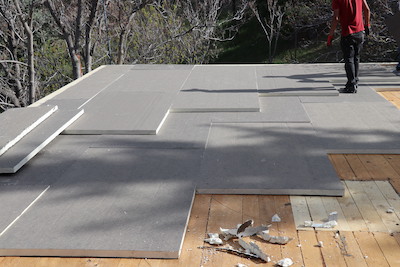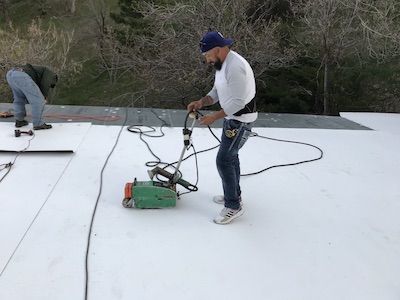Inspection Concerns



Find PVC Manufacturer's website here (scroll to the bottom)
PVC and TPO are very similar in their installation methods and failure modes.
Seams

Seams are heat-welded either by machine (excellent) or by hand (depends on the skill of the applicator). You should test seams using a pick and comment on weak or failed seams. The membrane laps must be clean before welding begins or seams may be weak. Properly-welded seams are very strong.
Seams may be improperly welded by those performing hand-welding but lacking skills. Even those using electric welding machines can make the mistake of using the wrong temperature settings.
Seams should be probed with a pick like the one to the left.
Flashing
Look for improper materials or methods.
Blisters
Blisters can develop in PVC for several reasons:
Inadequate flash-off time: Some sealants need time for solvents to off-gas. If the membrane is mated to the substrate without allowing inadequate time of off-gassing, blisters may appear as a result.
Entrapped air/moisture: If the roof deck is damp or has gaps, when the membrane gets hot, moisture vapor/air will expand, causing the overlying membrane to lift, forming a blister.
Don't recommend that blisters be repaired unless they are damaged. Blisters do not affect the water-tightness of the roof, but a repair might. Also, warranties often cover water tightness but not blisters.
Damage
- Hail or wind-borne missiles;
- Uplift;
- Foot traffic
- Careless workmen
Incompatibilities
PVC is not compatible with asphalt.
PVC should not be in direct contact with extruded polystyrene (styrofoam) or expanded polystyrene (bead board). Over time, these substrates will absorb plasticizers and the membrane will suffer premature embrittlement.
Air Movement Across the Membrane
A characteristic of mechanically attached membranes is that they are subject to lifting between fasteners. This condition is commonly called flutter, bellowing, or ballooning, and may be active, static, or a combination of the two.
Whatever form is evident, it is an indication of air exchange between the building interior and exterior, typically caused by pressure differentials created by wind. Wind directed over the roof creates low pressure above the membrane due to loss of laminar flow. This condition causes the membrane to lift, which in turn creates low pressure beneath the membrane that pulls air into this area from the building interior. This condition creates two problems:
It contributes to mechanical fatigue of various roof assembly components, including the field membrane, flashings, mechanical attachment components, and the roof deck.
It has the potential to raise moisture levels in the roof assembly.
This condition may be caused by the lack of an air retarder installed above the substrate. An inspector might identify this condition as a problem, but would not recommend correction because of excessive expense.
Heat-source Degradation
Some PVC membranes, especially those manufactured before about 2009, have a reputation for degradation/accelerated aging from heat sources including direct and reflected solar radiation and thermal loading from heat-emitting, roof-mounted mechanical equipment, heat exhausting vents or materials laid on the roof that may retain heat.
Reflected sunlight may be from glass, metal, or highly reflective curtain walls or flashing.
PV systems are a concern, not only because they are large and dark and retain heat, but also because anchoring the arrays may create penetration-related problems, especially with ballasted systems.
Not all TPO is the same in its vulnerability to heat accelerated degradation. Different formulas have been used over the years and variation in TPO performance characteristics varies by manufacturer. Inspectors working in hotter climates should be especially aware of the potential for heat-related problems and vigilant in looking for heat sources and areas of deterioration.
ABOUT PVC
PVC was first introduced into the North American market in the early 1990s. It is a single-ply, thermoplastic roofing material supplied in sheets and compounded from polypropylene and ethylene- propylene rubber polymers. Seams are hot-air welded according to manufacturer’s recommendations. Unlike PVC, it varies in feel, from soft and flexible to rigid and board-like.
PVC is manufactured with various quantities and formulations of fire retardants, UV resistance and resistance to heat-aging.
It has the following general attributes:
- Resistant to bacterial growth;
- Resistant to degradation from animal fats, some hydrocarbon oils, and vegetable oils;
- Typically white or tan but available in other colors
- Typically not warrantied against ponding
Their resistance to animal fats means that inspectors may see them used on restaurant roofs.
Fire Resistance
PVC is naturally fire resistant and self-extinguishing.
Thickness
PVC roofing is available in 36, 45, 60, 72, and 90 mil thicknesses. Thicker membranes allow for more stabilizers and greater breaking strength and thickness over scrim, which improves puncture resistance. For these reasons, the national Roofing Contractor’s Association (NRCA) recommends a minimum thickness of 45 mils for single-ply PVC roofing applications.
Reinforcement
PVC membranes are typically internally reinforced with woven polyester scrim or fabric that is positioned during manufacturing near the middle of the finished thickness.
Attachment
PVC membranes may be mechanically fastened, adhered or ballasted, according to the manufacturer’s recommendations, typically depending on the roof deck material.
Flashing
Penetration and corner flashings are typically pre-formed, compatible plastic, but may also be pre-formed sheet metal with PVC membrane bonded to it for adhesion to the field membrane.
Where multiple pipes or conduit penetrate the roof together, pitch pans (pitch pockets) are used. Pitch pans are flanged containers sealed to the membrane, through which pipes or conduit penetrate the roof, and that are filled with a sealant. Sealant should be crowned above the lip of the pitch pan to shed water. before sealant is applied the penetrations should be caulked and primer applied. Lack of caulking may allow sealant to drip down through the penetration.
Accessories
Accessories include pre-formed flashing, adhesives, sealants, and pourable sealants.
INSTALLATION TYPES
Mechanically Attached Membranes
Membranes are mechanically attached to substrates using a variety of fasteners and fastening schedules:
Fastener Types
Although fasteners will typically not be visible during inspections, knowledge of acceptable fasteners will contribute to overall understanding of single-ply roofing systems. Some manufacturers allow the use of commonly available fasteners, others require specialized, pre-assembled fastening components.
Fastener choices may be influenced by roof deck types, warranty considerations, and proprietary manufacturer’s concerns.
Fastening methods:
- Nailing disks placed within seams and fastened through the membrane to the substrate. No closer to edges than 6".
- Metal or plastic bars placed within seams and fastened through the membrane to the substrate.
- Metal or plastic bars over disks placed over the membrane, fastened through the membrane to the substrate, and covered with a strip of TPO membrane.
- Polymer-coated metal disks used with fasteners to attach rigid board insulation to roof decks and heat-welded to the underside of thermoplastic (TPO/TPO) membranes using electromagnetic induction welding equipment.
- Other proprietary methods.
Fastening Schedules, Sheet Installation, and Uplift
Fastening schedules and sheet installation will vary according to wind exposures, which in turn vary by area, roof shape, slope, height, and orientation to the prevailing winds. Designers often specify half-width sheets with an increased number of fasteners be installed near roof perimeters and corners where uplift is expected to be higher, so inspectors may see this condition in certain areas. If these precautions are lacking, look for evidence of problems relating to uplift in these areas.
Adhered Membranes
Adhesives
Adhered membranes are typically applied using a liquid-applied contact adhesive, although some have fleece backing that allows other types of adhesives to be used, and some are self-adhesive.
With adhered membranes, the resistance to wind-source uplift previously described is dependent upon the method of attachment of the base sheet or rigid board insulation to which the membrane is adhered.
Application
Smooth-back Membranes:
Smooth-backed membranes use cold-applied bonding adhesives to bond TPO membranes to substrates. Adhesives are typically applied with a roller, but may be also applied by spray, brush, or squeegee. Application may be to the membrane, or to both the membrane and substrate. Seams should not receive any bonding adhesive.
Before the membrane is mated to the substrate, the adhesive is given time to flash-off (partially cure). Once the membrane is mated to the substrate, it is brushed or rolled to promote good bonding.
Fleece-backed Membranes
Fleece-backed membranes may be adhered with cold-applied adhesive, hot asphalt, or low-rise foam. A large variety of adhesives are available that inspectors will have no way of identifying, and each having manufacturers requirements with which inspectors will not be able to confirm compliance. Home inspectors are not required to confirm proper installation, and application information supplied here is meant only as general information.
Ballasted Membranes
PVC may be applied as a loose-laid (not attached to the substrate) membrane, secured to the roof only around its perimeter and held in place in the field by the weight of gravel, typically ¾" to 1 ½" in size and applied at a rate of 1,000–1,200 lbs. per 100 sq. ft. Pavers may also be used for ballast.
Perimeter securement may be made with or without fasteners, and either penetrating or non-penetrating types may be used. Most methods are proprietary and fasteners will typically not be visible.
Concerns are wind and the ability of the structure to support the additional weight. Inspectors should look for signs of problems caused by these issues. Because most of the membrane will be hidden, inspections of these roofs will be very limited and they should be disclaimed for those without specialist training exceeding that provided by home inspection courses.
